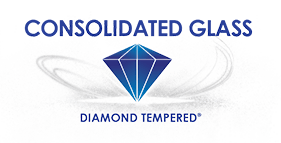GLOSSARY OF COMMONLY USED TEMPERED GLASS TERMS
GENERAL TERMS
ANNEALED GLASS: Float, plate, sheet or rolled glass that is basically free of residual internal stresses so that it can be easily cut. Annealed glass, sometimes referred to as ordinary, raw or unenhanced glass may be flat or bent.
ANSI Z97.1: American National Standard for Safety Glazing Materials used in Buildings. It contains Safety Performance Specifications and methods of test. See related term CPSC.
BREAK PATTERN: The resultant pattern formed by the cracks within an individual lite of glass when broken. Also called fracture pattern. See DICE.
BOW AND WARP: Departure from flatness that is normally inherent in glass that has been thermally treated.
CENTER TENSION: Tension stresses within the center portion of the thickness of heat-treated glass.
CPSC: Acronym for Consumer Product Safety Commission, a USA federal agency. CPSC standard 16 CFR 1201 – Safety Standard for Architectural Glazing Materials requires safety glazing in certain hazardous locations and specifies the test criteria and certification for safety glazing materials. See related term ANSI Z97.1
DICE: The individual fragments of broken fully tempered glass.
DISTORTION: Alteration of viewed images usually caused by variations in glass flatness or inhomogeneous portions within the glass body. See related term roll distortion.
EDGE COMPRESSION: Compressive stresses at the edges of heat-treated glass.
EDGE FINISH: Specified finishes to the edges of glass. Sometimes called Edgework.
FLAT GLASS: A general term covering float glass, sheet glass, plate glass, rolled and wired glasses.
FLOAT GLASS: Flat glass that has been formed on molten metal, commonly tin.
FRACTURE PATTERN: The resultant pattern formed by the cracks within an individual lite of glass when broken. Also called break pattern. See DICE.
FULLY TEMPERED GLASS: Flat or bent glass that has been thermally tempered to a high surface and/or edge compression to meet the requirements of ASTM C 1048 kind FT.
HEAT-TREATED GLASS: Glass which has been heated to near its softening point and quenched by rapidly cooling with air. Heat-treated glass may be either heat-strengthened or fully tempered.
HEAT-STRENGTHENED GLASS: Flat or bent glass that has been thermally tempered to a specific surface and/or edge compression range to meet the requirements of ASTM C 1048 kind HS. Note: Heat-strengthened glass is not considered a safety glass unless laminated to meet a safety glass standard.
IRIDESCENCE: A display of rainbow-like colors. See related terms STAIN, STRAIN PATTERN AND QUENCH marks.
KINK: An abrupt deviation from a flat plane or the normal contours of box and warp, and most commonly found near the edge of a piece of heat-treated glass.
POLARISCOPE: An instrument employed to determine the degree of residual stress in glass.
QUENCH or QUENCHING: To rapidly cool.
QUENCH MARKS: A pattern of dark shadows sometimes called Quench Pattern. See STRAIN PATTERN.
ROLL DISTORTION: Waviness imparted to horizontally heat-treated glass while the glass is transported through the furnace on a roller conveyor. The waves produce distortion when the glass is viewed by reflection. Also called Roll Wave.
ROLLED GLASS: Flat glass manufactured by forming a ribbon of glass with a pair of machined or engraved forming rolls. The rolls impress their surface pattern into the glass surfaces. Also called Patterned and Figured glass.
SAFETY GLASS: Glass so constructed, treated or combined with other materials to meet a required safety glass standard by reducing, in comparison to unenhanced glass, the likelihood of cutting and piercing injury by the glass should it be broken by human impact. See related terms FULLY TEMPERED GLASS.
SHEET GLASS: Flat glass formed by vertically drawing a ribbon of glass from a container of hot glass. Sheet glass has been almost completely replaced by float glass.
SPANDREL GLASS: Glass used in non-vision areas of a building.
STAIN: Chemical corrosion on the surface of glass which manifests itself by an iridescence or whiteness. Stain is frequently caused by moisture trapped between adjoining sheets of glass that are in storage.
STRAIN PATTERN: A specific geometric pattern of iridescence or darkish shadows that may appear under certain lighting conditions, particularly in the presence of polarized light. Also called quench marks. The phenomena is caused by the localized stresses imparted by the rapid air cooling (quench) of the tempering operation. Strain Pattern is a characteristic of heat-treated glass.
SURFACE COMPRESSION: Compressive Stresses at and beneath the surfaces of heat-treated glass and balanced by the CENTER TENSION stresses.
TEMPERED GLASS: Flat or bent glass that has been heat-treated and rapidly cooled to produce compressively stressed layers at the surfaces.
TENSION: Sometimes called tension zone. See CENTER TENSION
TOUGHENED GLASS: A term sometimes used by foreign manufacturers for heat-treated or fully tempered glass.
16 CFR 1201: See CPSC
DISCLAIMER
The information in this Glossary is to the best knowledge of the Consolidated Glass Corporation (CGC) considered to be true and accurate, but all recommendations or suggestions are made without guarantee. Since the conditions of use are beyond the control of the Consolidated Glass Corporation (CGC), Consolidated disclaims any liability for loss or damage suffered from the uses of data and/or suggestions and recommendations contained in this Glossary.
